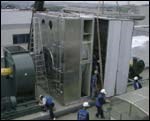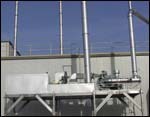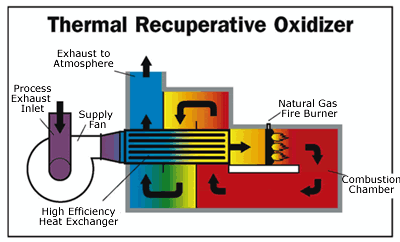MON MACT Impact
The clock is ticking for paint and coating operations to reduce HAP emissions and meet EPA guidelines.
November 10, 2003 will likely be viewed as a watershed date by paint and coatings operations across the country. On that date, the United States Environmental Protection Agency (EPA) published the final MON MACT rule that strictly limits air emissions from batch and continuous chemical manufacturers including paint and coatings companies. Existing facilities impacted by the new rule have until November 10, 2006 to be in full compliance with the provisions.
What is MON MACT?
According to the EPA’s Proposed Standards for Hazardous Air Pollutant Emissions from Miscellaneous Organic Chemical Manufacturing and Miscellaneous Coating Manufacturing published in September 2001, Section 112 of the Clean Air Act (CAA) authorizes the EPA to establish national standards to reduce air emissions from sources that emit one or more hazardous air pollutants (HAPs). Section 112(b) lists the HAPs to be regulated under such standards, while section 112(c) directs the EPA to use this information to develop and publish a list of source categories for which national emission standards for hazardous air pollutants (NESHAP) will be developed.
The EPA must list all known source categories and subcategories of “major sources” that emit one or more of the listed HAPs. Section 112(a) defines a major source category as “any stationary source or group of stationary sources located within a contiguous area under common control that emits, or has the potential to emit, in aggregate, considering controls, 10 tons per year or more of any one HAP or 25 tons per year or more of any combination of HAP.”
The list of source categories includes several organic chemical processes collectively organized in the Miscellaneous Processes Group. The processes in this miscellaneous group form the basis of the source categories addressed by the standards known as the Miscellaneous Organic NESHAP (MON). In order to control, reduce or otherwise limit hazardous air pollutant emissions from miscellaneous organic chemical processes, add-on controls are often required to achieve such reductions as part of the process known as maximum achievable control technology (MACT).
More than 120 different organic and inorganic HAPs are emitted from major sources covered by the MON, but only eight HAPs account for approximately 75% of total HAP emissions. These are methanol, hydrochloric acid, cresols, methylene chloride, methyl ethyl ketone, toluene, xylene and vinyl acetate.
What Impact Will MON MACT Have?
MON MACT is likely to affect both existing and future facilities across the country and will apply to all batch and continuous chemical manufacturers not already subject to a MACT rule. It will cover the production of a variety of substances including paints, coatings, inks, adhesives and resins, and it is designed to regulate major source HAP emissions from process vents, storage tanks, wastewater streams, transfer operations and equipment leaks (fugitive emissions).
Emissions from these operations will be strictly limited and will require coating and resin manufacturers to install covers and add-on control equipment to reduce HAPs. For example, under the new guidelines, 98% of HAP emissions from transfer operations and process vents must be controlled; 95% of emissions from storage tanks must be controlled. Because the new ruling determines a facility’s source category based on both current emissions as well as the potential to emit, it’s possible the rule could apply to facilities even though they fall below current emissions thresholds.
Emission Control Technology Options
Complying with the new emission regulations could involve major capital outlays or changes in basic process operations for some facilities. To determine if a facility falls under the category of a major source for HAPs, the plant manager should perform a thorough emissions inventory.
Once the emissions that fall under the MON rule have been identified along with current control requirements, managers can review various control options. In some cases, a facility that exceeds a HAP limit by only a small amount might be able to replace those HAPs with non-HAP VOCs. In other situations, the installation of a control device might be required to destroy the HAP emissions before they are released to the outside atmosphere.
Companies trying to determine the best control method for their application should seek input from a number of knowledgeable sources, including their own plant operations or engineering staff, internal safety/maintenance/environmental personnel, outside design and construction firms, equipment vendors and various regulatory agencies.
The final selection of an emission control technology often comes down to the actual makeup of the emission sources and related vent streams. While there are several control technology options available, thermal oxidation is often considered because of its ability to accommodate a broad variety of vent stream characteristics and provide high destruction efficiencies. Included in this category are thermal oxidizers, regenerative thermal oxidizers and catalytic oxidizers. For larger air streams, a hybrid rotary concentrator/oxidizer system could be designed to reduce the oxidizer size and minimize operating costs.
Thermal Oxidizers
The basic design concept of thermal oxidation is to promote a chemical reaction of the HAP/VOC with oxygen at elevated temperatures—i.e., burning. This reaction destroys the pollutant in the air stream by converting it to carbon dioxide, water and heat.
Thermal oxidizers utilize a multi-pass shell-and-tube type heat exchanger fabricated from heavy-duty stainless steel. In operation, a high-efficiency, stainless steel, counter-flow type heat exchanger is used to preheat the incoming process exhaust air stream.
After preheat, the exhaust stream is directed through a gas-fired burner (as may be needed to reach required temperatures) and is thoroughly mixed with oxygen and then held at elevated temperatures in the combustion chamber. Environmental compliance is achieved as more than 99% of the HAPs or VOCs present in the original exhaust stream are destroyed before release to the outside atmosphere.
Regenerative Thermal Oxidizers
Regenerative thermal oxidizers (RTOs) are designed to destroy up to 99.9% of VOCs/HAPs present in process air streams. In operation, a supply fan forces the process exhaust stream into the RTO inlet manifold and into one of the energy recovery canisters by inlet control (switching) valves. The air passes from the valve assembly vertically upward through the first of two heat exchanger canisters, where it adsorbs heat from the ceramic media, thus cooling the media and preheating the air stream.
This preheated air then enters the combustion chamber (typically at a temperature very close to that required for oxidation), where it is further heated to 1,500°F for a minimum of 0.5 seconds—a time sufficient to achieve high VOC/HAP destruction efficiency. Destruction takes place within the combustion chamber, where auxiliary fuel is introduced if necessary.
The clean, hot air is routed vertically downward through a second energy recovery canister. Here, the heat generated during thermal oxidation is adsorbed by the ceramic media (thus cooling the air and preheating the media). The cooled air is routed to atmosphere through outlet control (switching) valves, the exhaust manifold and ultimately through the exhaust stack. To maximize the heat exchange, the switching valves alternate the airflow path between the canisters to continuously regenerate the heat stored within the ceramic media.
To help reduce energy costs, RTOs can be equipped with add-on devices that provide up to 97% recovery of the heat the system would normally exhaust out the stack to the atmosphere. The recovered heated air can be used for a variety of applications, including warehouse or building comfort heating and process make-up air. In some cases, it can completely replace natural-gas-fired burners in the manufacturing process.
Catalytic Oxidizers
A catalytic oxidizer destroys HAPs and VOCs at temperatures ranging from 500 to 650°F. This technology uses an industrial-grade precious-metal catalyst to promote oxidation, which is achieved when the process exhaust fumes are passed through the heated catalyst chamber. VOC destruction efficiencies 98% or more typically can be guaranteed. An energy-efficient catalytic oxidizer will utilize a high-efficiency, air-to-air heat exchanger to preheat the incoming exhaust fumes, thus further reducing the unit’s operating costs.
Rotary Concentrators
A Rotary concentrator/regenerative thermal oxidizer (RTO) system is a hybrid air pollution control system. Application of this technology is limited to exhaust air streams at or near ambient temperature. The system’s two-step process removes VOC/HAP from the air stream using a hydrophobic zeolite rotating wheel followed by destruction of the concentrated VOC/HAP using a RTO.
In operation, process emissions captured via a ductwork collection system typically pass through a three-stage, high-efficiency filter box, because particulate can damage the concentrator wheel media. Once filtered, the solvent-laden air passes through the slowly rotating concentrator wheel, where VOC/HAPs are adsorbed onto the hydrophobic zeolite media. Approximately 10% of this air is routed through a cooling plenum; the remainder is discharged directly to atmosphere with a VOC/HAP removal efficiency of 96% plus.
The rotor is manufactured from a corrugated mineral fiber substrate to which a proprietary mixture of hydrophobic zeolite and inorganic materials is permanently bonded.
The concentrator wheel rotates at approximately 2-8 revolutions per hour, continuously passing a sector of the wheel with adsorbed VOC/HAP through a desorbtion plenum for removal by a heated air stream and returning a regenerated sector back into the main housing for further adsorbtion. Desorbtion is automated, because the slip stream of air that was routed through the cooling plenum is sent through a supplemental desorbtion heater where it is elevated to desorbtion temperature (typically ~350°F) and returned to the concentrator housing. This heated desorbtion air is directed back through the wheel via the desorbtion plenum, where the concentrated VOC/HAPs are removed. The concentrated stream of solvent-laden air is then routed to the RTO for thermal destruction. The RTO is designed to achieve more than 99% VOC/HAP destruction, resulting in an overall combined destruction efficiency of 95% plus.
Control Options
If, after a thorough review of the new emission guidelines, a facility determines that it needs to act to achieve compliance, there are typically three control strategies available:
- Using alternative control options allowed by the MON rules
- Using existing control systems
- Using add-on controls or new control technology.
If addition of new control technology is required, there are several points that should be addressed in order to provide a control solution that best meets the individual needs of your facility. These include:
- Does the new control technology meet all local and state clean air regulations?
- Are you familiar with the proposed technology? Is it reliable?
- Are there any safety issues to be concerned with?
- How will the new equipment fit into your current operation?
- How much downtime will be needed for installation?
- Will it be adaptable to accommodate future increases in business volume?
- How much time will be required to implement the new control solutions?
- What are the costs of the new technology including purchase price and yearly operating and maintenance costs?
- Will you be able to handle any testing, monitoring or record keeping the new equipment might require?
With the MON MACT compliance deadline for existing facilities less than a year away, paint and coating manufacturers who have not yet done so need to determine the impact of the new ruling and select a cost-effective compliance strategy that will best serve their operation.
Related Content
NASF/AESF Foundation Research Project #121: Development of a Sustainability Metrics System and a Technical Solution Method for Sustainable Metal Finishing - 15th Quarterly Report
This NASF-AESF Foundation research project report covers the twelfth quarter of project work (October-December 2023) at Wayne State University in Detroit. In this period, our main effort focused on the development of a set of Digital Twins (DTs) using the Physics-Informed Neural Network (PINN) technology with application on parts rinsing simulation.
Read MoreTop 5 Areas to Consider Automation of Plating Operations
Automation for finishing operations can lead to improvements in process time, repeatability and consistency of quality. Yet, processes that make sense to explore for these operational efficiencies may not always be readily apparent.
Read MoreHubbard-Hall Acquires BioConversion Technology
The acquisition adds experience and biologics to the AquaPure product line.
Read MoreNovel Wastewater Treatment Targets Micropollutants
Swiss wastewater treatment technology provider Oxyle specializes in advanced wastewater treatment for removal of highly persistent micropollutants such as PFAS.
Read MoreRead Next
Episode 45: An Interview with Chandler Mancuso, MacDermid Envio Solutions
Chandler Mancuso, technical director with MacDermid Envio discusses updating your wastewater treatment system and implementing materials recycling solutions to increase efficiencies, control costs and reduce environmental impact.
Read MoreDelivering Increased Benefits to Greenhouse Films
Baystar's Borstar technology is helping customers deliver better, more reliable production methods to greenhouse agriculture.
Read MoreEducation Bringing Cleaning to Machining
Debuting new speakers and cleaning technology content during this half-day workshop co-located with IMTS 2024.
Read More

























